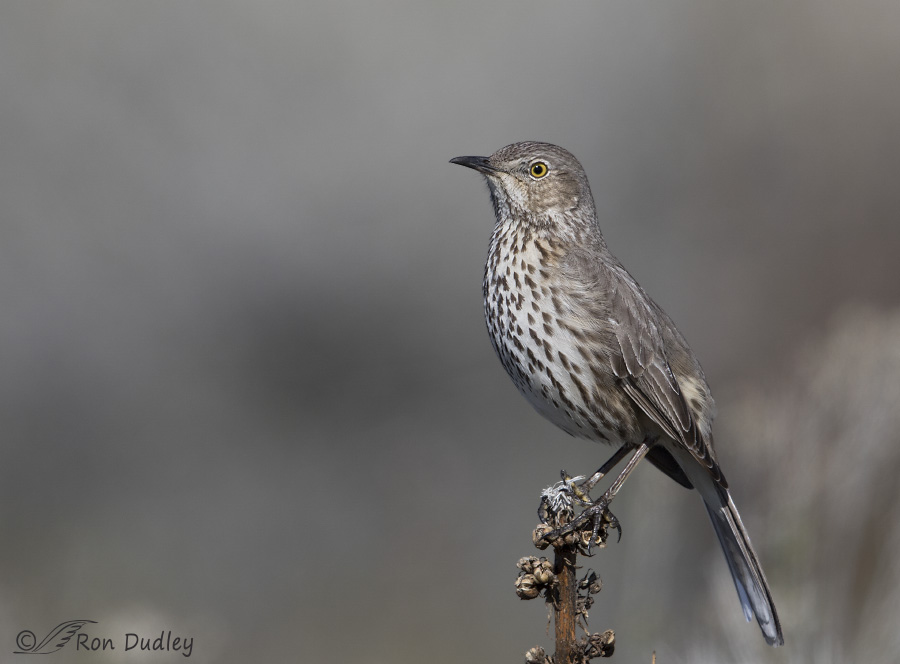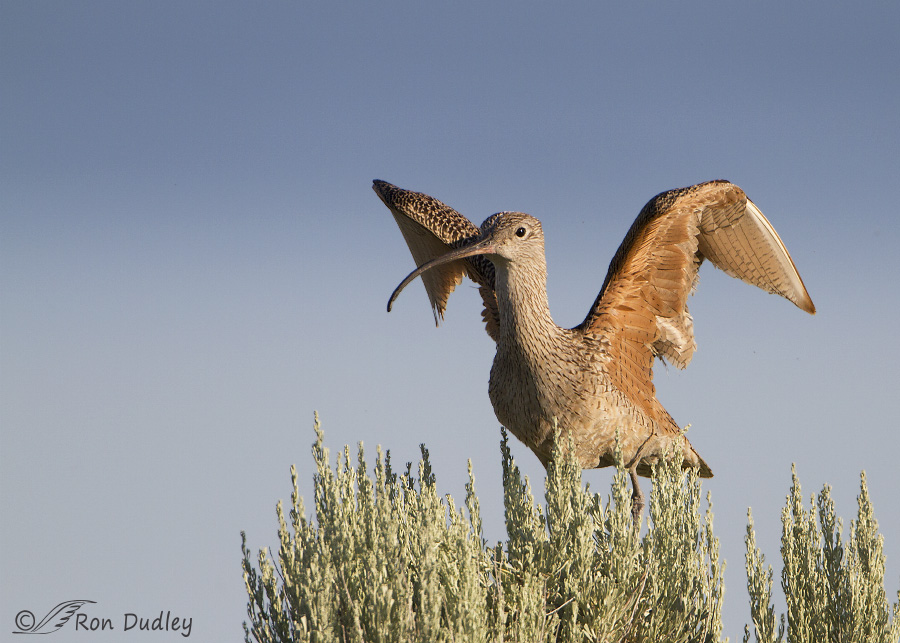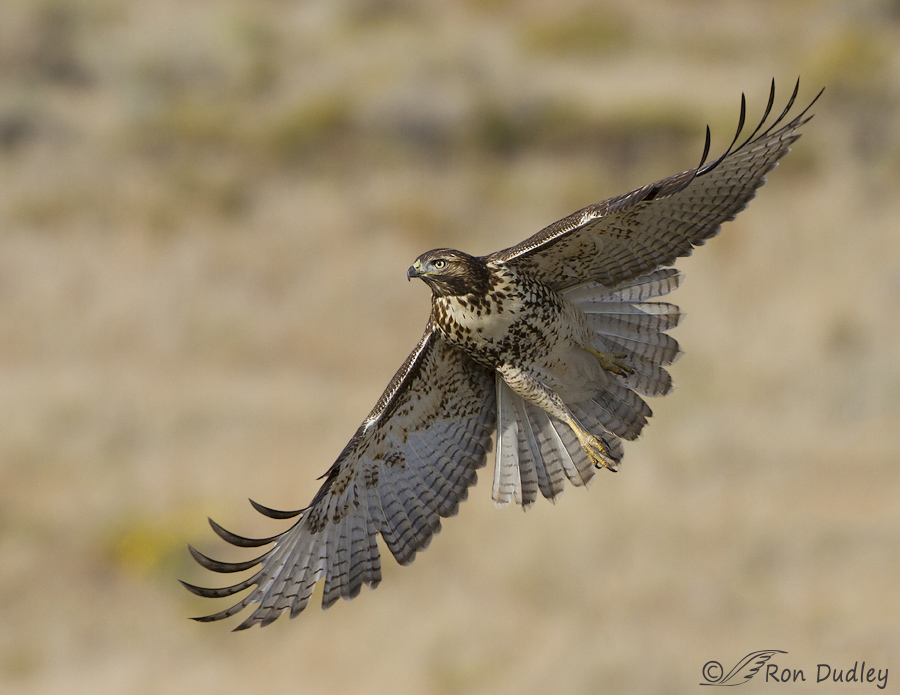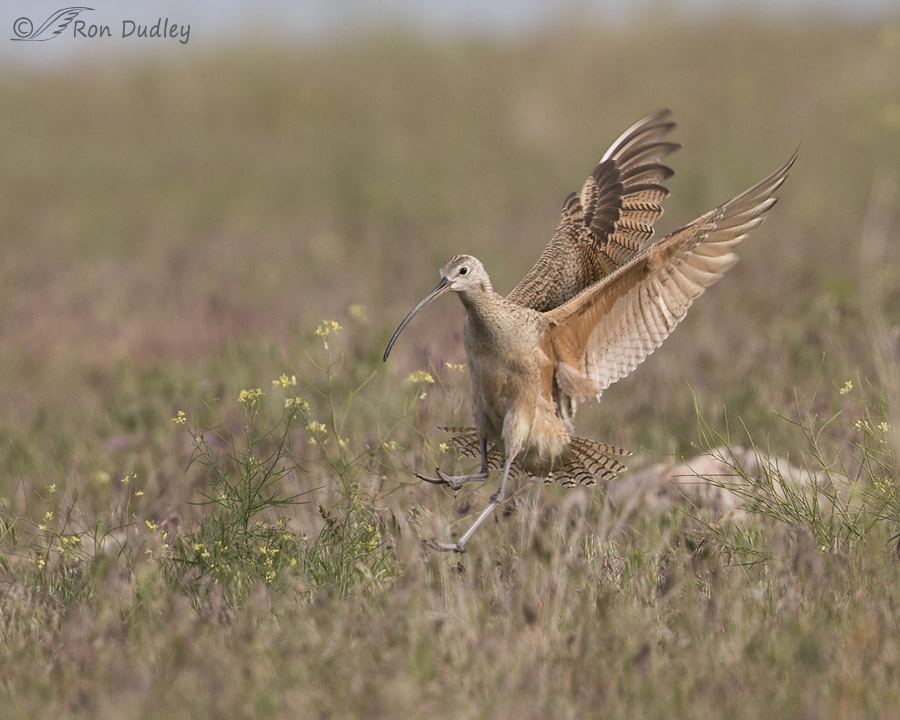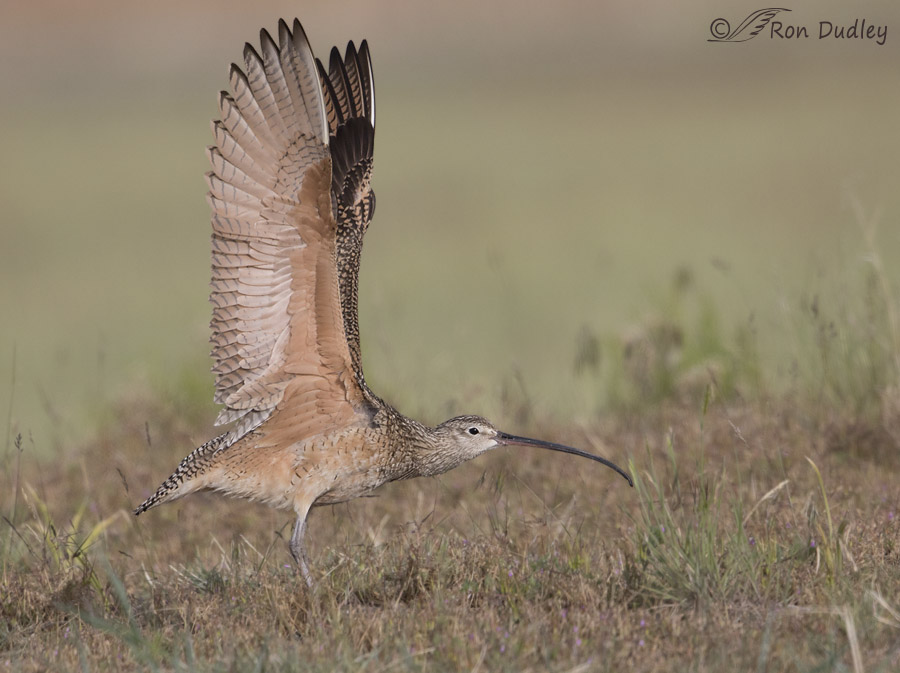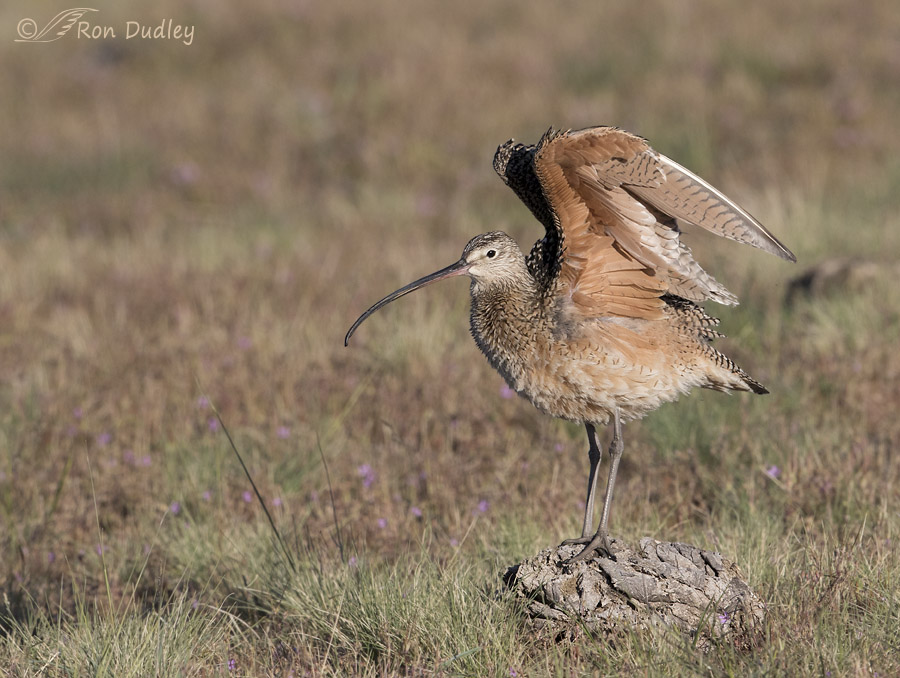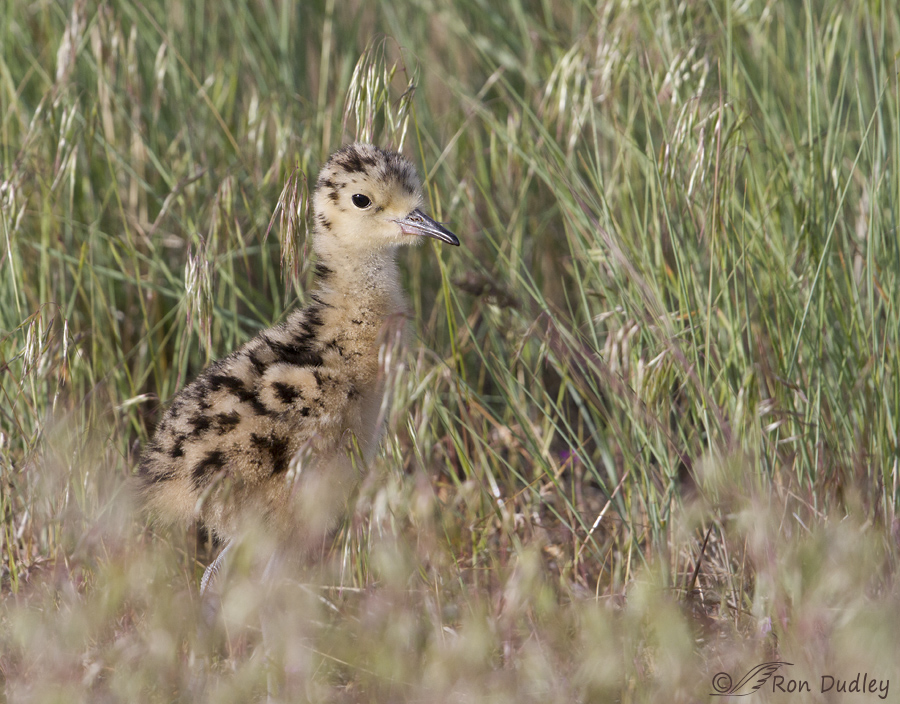Tag: long billed curlew
Long-billed Curlew On Sagebrush
Some Pet Peeves Regarding Birds And Terminology
Curlew Landing Amongst The Flowers
Curlew Wing-lift
Curlew Poop-stretch
Long-billed Curlew Chick (and the length that bill must grow!)
Long-billed Curlew And Fledgling
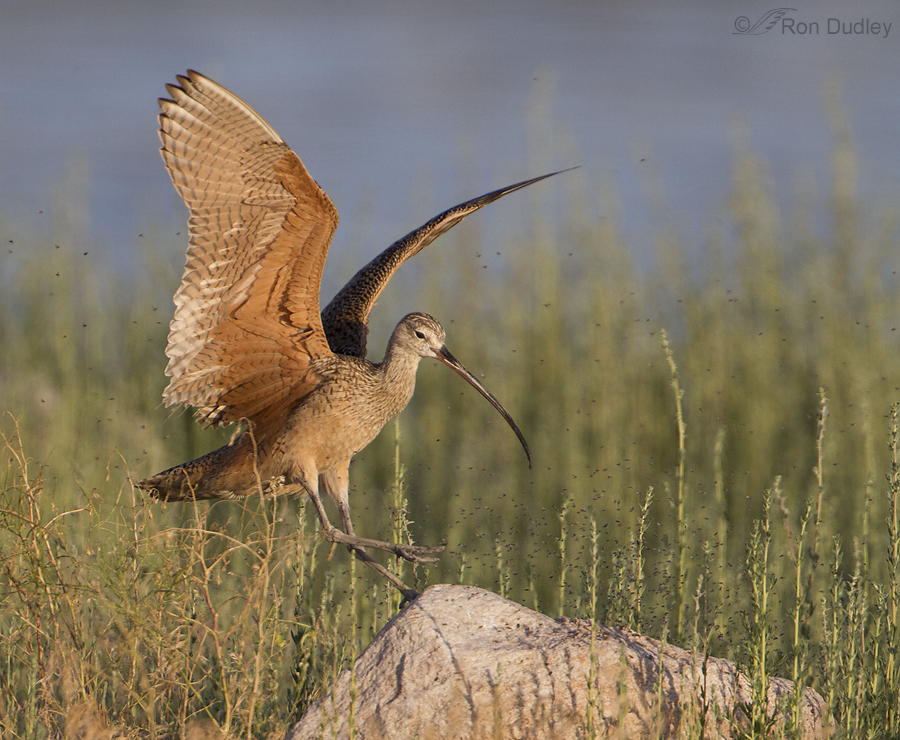
Long-billed Curlews spend most of the late spring and early summer at mid-elevations on Antelope Island while nesting and raising their chicks but by this time of year they begin to bring the youngsters down to the shoreline. That’s where I photographed this lone adult with a single youngster yesterday morning.
Long-billed Curlew – A Running Start
Just another little trick of a bird photographer and it worked this time.
Long-billed Curlew Courtship Behaviors
A week ago today, on 3/29/13, I photographed a pair of courting Long-billed Curlews on Antelope Island. For sexual ID purposes, notice that the female of this species (on the right in this first image) is larger than the male and has a significantly longer bill. It’s also been my observation that the male is darker and redder than the female but I don’t see that mentioned in the physical descriptions in the field guides and other sources that I’ve read.
Long-billed Curlews Have Finally Returned To Antelope Island
One of my favorite birds on the island is the Long-billed Curlew. They’ve been gone for a long time and I’ve missed them but they’re back now, as of two days ago.
The Mystery Of The Curlew Egg
A couple of days ago we spotted a far off Long-billed Curlew in flight with something in its bill. It was much too distant for decent photos but I was curious about what it was carrying so I scoped it with my 500mm. Even at that great distance it was obvious that the bird was carrying an egg. I actually fired off a couple of frames but the curlew was so far away that I just deleted those images when I got home. I wish I hadn’t now… I’ve seen and photographed birds carrying egg fragments from the nest after the hatching of their chicks multiple times but this seemed a little strange because it looked like an entire egg rather than just a fragment (which I didn’t think at all likely or even possible). Another thing that strikes me as unusual is the fact that this bird was several hundred feet in the air and flew a significant distance with the egg even though BNA Online says that when curlews dispose of eggshells they fly only “several meters” from the nest before alighting to drop the shell. We watched the bird fly and then eventually land on a gravel road where we were able to find the abandoned egg. Here you see it undisturbed as we found it. Now I’m no curlew expert but I’m going to speculate that this egg didn’t “hatch”. It doesn’t look like it has been pipped from the inside by the egg tooth of the chick and besides the hole in the egg simply has to…
Curlew Peekaboo Take-off
When Long-billed Curlews take off they have a little trick they use to get airborne quickly. This is our largest North American shorebird and in addition to their extremely long bill they have very long legs. Since this is a grassland species it would often be very difficult to get a running start at take-off through the tall vegetation so they use their long legs to full advantage by crouching so low that their belly often touches the ground and then they spring into the air by quickly straightening those very long legs (jumping). This can be problematic for the photographer wishing to get take-off shots because this is a large bird and they explode into the air so quickly that you tend to either cut off part of the bird or lose focus on the subject at the most critical point of the take-off. But knowing and anticipating their behavior can give you a better chance at a quality shot or two. These three images from yesterday on Antelope Island are sequential in a quick burst at take-off. The first two are of crappy quality but I include them to illustrate my point. Here the curlew has crouched as low as it can get prior to take-off. I temporarily lost sharp focus on the head because of the foreground vegetation and because of camera movement as I moved my aim upwards in an attempt to get the entire bird in the frame as it lifted off. In the second shot of the burst, focus has locked onto the bird again as…
Sagebrush Perches
For me there’s just something wonderful about sagebrush. In fact, lots of things. When sagebrush is wet its smell is almost intoxicating (at least it is for me). When walking through it that scent comes wafting up and my mind can’t help but wander through old memories and cowboy songs. I love the silvery-gray-green color it lends to a hillside. The presence of sagebrush is essential for many species for nesting, habitat, protection or food. Sage Sparrows, Sage Thrashers and Loggerhead Shrikes nest within the plant and larks, Burrowing Owls and Long-billed Curlews nest on the ground in stands of sagebrush. Sagebrush dominates the diet of the Sage Grouse during late fall, winter and early spring. It also makes for an interesting perch for bird photography even though its growth patterns often put obstructions in front of the bird. Since sage is the dominant plant of the Great Basin in many areas I have regular opportunities to photograph birds perched on it. The various species (Big Sage and Black Sage for example) provide variety in color and leaf shape and sometimes you catch the bird on bare twigs or branches or layers of snow/ice on top of the plant. 1/1000, f/8, ISO 500, 500 f/4, 1.4 tc I photographed this Lark Sparrow on sage yesterday – as you can see, the leaf colors are a soft silvery green in early spring. 1/2000, f/8, ISO 500, 500 f/4, 1.4 tc And this Loggerhead Shrike is from this morning, with the Great Salt Lake (not sky) in the background. I thought I’d…
The Timelessness of a Buffalo Chip Perch
The American Bison is a relative newcomer to North America, having migrated from Eurasia over the Bering Straight about 10,000 years ago. As is common knowledge they once roamed in massive herds across most of the continent until commercial hunting and slaughter reduced their numbers to a few hundred by the end of the 19th century. 1/500, f/6.3, ISO 500, 500 f/4, 1.4 tc Today a herd of approximately 500 animals roams free on Antelope Island and that many large animals produce a lot of poop – commonly referred to as “buffalo chips”. Those chips are all over the island – like small dark islands in a sea of prairie grasses and tiny flowers and they’re tempting perches for a variety of bird species like Horned Larks and Meadowlarks. But this past week I was able to catch some larger birds using them as perches. 1/2000, f/6.3, ISO 500, 500 f/4, 1.4 tc In the spring some of the shorebirds and wading birds come up from the shore of the Great Salt Lake to higher ground on the island for their breeding activities – Long-billed Curlews among them. It seems that the added height of only a couple of inches provided by the chip is enough to significantly improve their view of the landscape for potential predators and also to help them keep an eye on other curlews in the area – there’s a lot of fighting and mating activities going on this time of year. To some viewers such a perch may have no aesthetic draw but I’m…
Long-billed Curlew On Sagebrush
Some Pet Peeves Regarding Birds And Terminology
Curlew Landing Amongst The Flowers
Curlew Wing-lift
Curlew Poop-stretch
Long-billed Curlew Chick (and the length that bill must grow!)
Long-billed Curlew And Fledgling

Long-billed Curlews spend most of the late spring and early summer at mid-elevations on Antelope Island while nesting and raising their chicks but by this time of year they begin to bring the youngsters down to the shoreline. That’s where I photographed this lone adult with a single youngster yesterday morning.
Long-billed Curlew – A Running Start
Just another little trick of a bird photographer and it worked this time.
Long-billed Curlew Courtship Behaviors
A week ago today, on 3/29/13, I photographed a pair of courting Long-billed Curlews on Antelope Island. For sexual ID purposes, notice that the female of this species (on the right in this first image) is larger than the male and has a significantly longer bill. It’s also been my observation that the male is darker and redder than the female but I don’t see that mentioned in the physical descriptions in the field guides and other sources that I’ve read.
Long-billed Curlews Have Finally Returned To Antelope Island
One of my favorite birds on the island is the Long-billed Curlew. They’ve been gone for a long time and I’ve missed them but they’re back now, as of two days ago.
The Mystery Of The Curlew Egg
A couple of days ago we spotted a far off Long-billed Curlew in flight with something in its bill. It was much too distant for decent photos but I was curious about what it was carrying so I scoped it with my 500mm. Even at that great distance it was obvious that the bird was carrying an egg. I actually fired off a couple of frames but the curlew was so far away that I just deleted those images when I got home. I wish I hadn’t now… I’ve seen and photographed birds carrying egg fragments from the nest after the hatching of their chicks multiple times but this seemed a little strange because it looked like an entire egg rather than just a fragment (which I didn’t think at all likely or even possible). Another thing that strikes me as unusual is the fact that this bird was several hundred feet in the air and flew a significant distance with the egg even though BNA Online says that when curlews dispose of eggshells they fly only “several meters” from the nest before alighting to drop the shell. We watched the bird fly and then eventually land on a gravel road where we were able to find the abandoned egg. Here you see it undisturbed as we found it. Now I’m no curlew expert but I’m going to speculate that this egg didn’t “hatch”. It doesn’t look like it has been pipped from the inside by the egg tooth of the chick and besides the hole in the egg simply has to…
Curlew Peekaboo Take-off
When Long-billed Curlews take off they have a little trick they use to get airborne quickly. This is our largest North American shorebird and in addition to their extremely long bill they have very long legs. Since this is a grassland species it would often be very difficult to get a running start at take-off through the tall vegetation so they use their long legs to full advantage by crouching so low that their belly often touches the ground and then they spring into the air by quickly straightening those very long legs (jumping). This can be problematic for the photographer wishing to get take-off shots because this is a large bird and they explode into the air so quickly that you tend to either cut off part of the bird or lose focus on the subject at the most critical point of the take-off. But knowing and anticipating their behavior can give you a better chance at a quality shot or two. These three images from yesterday on Antelope Island are sequential in a quick burst at take-off. The first two are of crappy quality but I include them to illustrate my point. Here the curlew has crouched as low as it can get prior to take-off. I temporarily lost sharp focus on the head because of the foreground vegetation and because of camera movement as I moved my aim upwards in an attempt to get the entire bird in the frame as it lifted off. In the second shot of the burst, focus has locked onto the bird again as…
Sagebrush Perches
For me there’s just something wonderful about sagebrush. In fact, lots of things. When sagebrush is wet its smell is almost intoxicating (at least it is for me). When walking through it that scent comes wafting up and my mind can’t help but wander through old memories and cowboy songs. I love the silvery-gray-green color it lends to a hillside. The presence of sagebrush is essential for many species for nesting, habitat, protection or food. Sage Sparrows, Sage Thrashers and Loggerhead Shrikes nest within the plant and larks, Burrowing Owls and Long-billed Curlews nest on the ground in stands of sagebrush. Sagebrush dominates the diet of the Sage Grouse during late fall, winter and early spring. It also makes for an interesting perch for bird photography even though its growth patterns often put obstructions in front of the bird. Since sage is the dominant plant of the Great Basin in many areas I have regular opportunities to photograph birds perched on it. The various species (Big Sage and Black Sage for example) provide variety in color and leaf shape and sometimes you catch the bird on bare twigs or branches or layers of snow/ice on top of the plant. 1/1000, f/8, ISO 500, 500 f/4, 1.4 tc I photographed this Lark Sparrow on sage yesterday – as you can see, the leaf colors are a soft silvery green in early spring. 1/2000, f/8, ISO 500, 500 f/4, 1.4 tc And this Loggerhead Shrike is from this morning, with the Great Salt Lake (not sky) in the background. I thought I’d…
The Timelessness of a Buffalo Chip Perch
The American Bison is a relative newcomer to North America, having migrated from Eurasia over the Bering Straight about 10,000 years ago. As is common knowledge they once roamed in massive herds across most of the continent until commercial hunting and slaughter reduced their numbers to a few hundred by the end of the 19th century. 1/500, f/6.3, ISO 500, 500 f/4, 1.4 tc Today a herd of approximately 500 animals roams free on Antelope Island and that many large animals produce a lot of poop – commonly referred to as “buffalo chips”. Those chips are all over the island – like small dark islands in a sea of prairie grasses and tiny flowers and they’re tempting perches for a variety of bird species like Horned Larks and Meadowlarks. But this past week I was able to catch some larger birds using them as perches. 1/2000, f/6.3, ISO 500, 500 f/4, 1.4 tc In the spring some of the shorebirds and wading birds come up from the shore of the Great Salt Lake to higher ground on the island for their breeding activities – Long-billed Curlews among them. It seems that the added height of only a couple of inches provided by the chip is enough to significantly improve their view of the landscape for potential predators and also to help them keep an eye on other curlews in the area – there’s a lot of fighting and mating activities going on this time of year. To some viewers such a perch may have no aesthetic draw but I’m…


